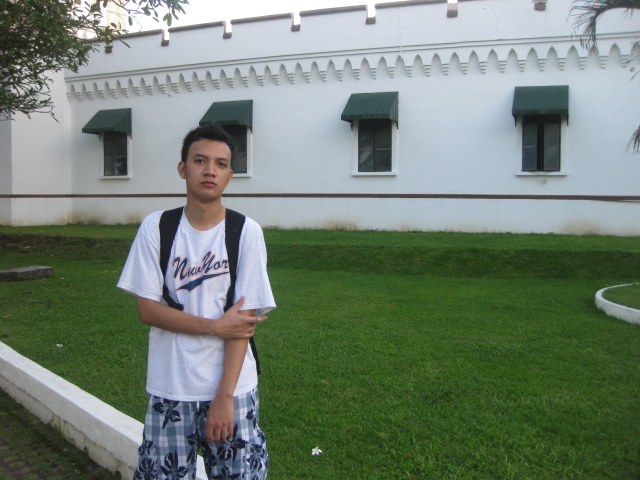10 Paintings, I have seen in the National Museum
Title: Planting of the First Cross (1965)
Artist: Vicente Manansala (1910-1981)
Material or Medium: oil on canvas
Subjective Context: The painting depicts the planting of the cross in Cebu in 1521 with Ferdinand Magellan, Spanish soldiers and the natives with intricate tattoos known as pintados. The original cross can still be found in a special kiosk in Cebu City. This mural painting is one of the best representations of historical artwork in the collection. Manansala’s rendition is an amalgamation of the traditional and modern techniques in painting. It also manifests his mastery of transparent cubism. The artwork was commissioned by the national government in celebration of the 400 years of Philippine Christianization held in Cebu in 1965.
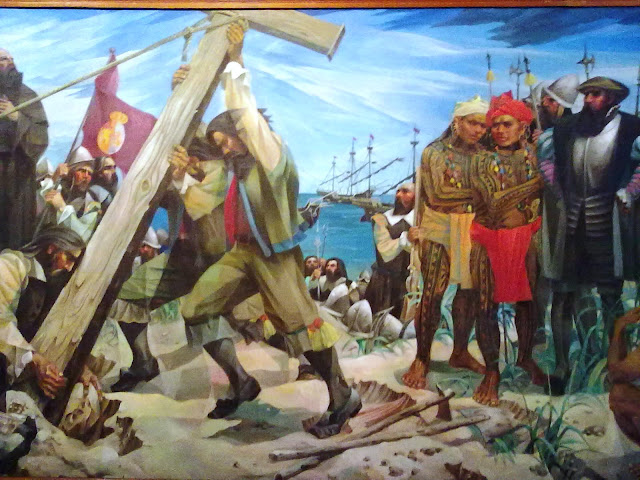 |
| Planting of the First Cross (1965) |
Title: Una Bulaqueña (1895)
Artist: Juan Luna
Material or Medium: oil on canvas
Subjective Context: La Bulaqueña, literally "the woman from Bulacan" or "the Bulacan woman", also sometimes referred to as Una Bulaqueña ("a woman from Bulacan"), is the Spanish title of an 1895 painting by Filipino painter and hero Juan Novicio Luna. Bulacan is a province in the Philippines in Luzon island and its residents are called Bulaqueños, also spelled as Bulakenyos (Bulakenyo for men and Bulakenya for women) in the Filipino language. It is a "serene portrait", of a Filipino woman wearing a Maria Clara gown, a traditional Filipino dress that is composed of four pieces, namely the camisa, the saya (long skirt), the panuelo (neck cover), and the tapis (knee-length overskirt). The name of the dress is an eponym to Maria Clara, the mestiza heroine of Filipino hero José Rizal's novel Noli Me Tangere. The woman's clothing in the painting is the reason why the masterpiece is alternately referred to as Maria Clara. It is one of the few canvases done by Luna illustrating Filipino culture. The painting is currently displayed at the so-called Music Room of the Malacañan Palace, the seat of the government of the Philippines.
 |
| Una Bulaqueña (1895) |
Title: Homage to Tandang Sora (1977)
Artist: Hernando R. Ocampo
Material or Medium: acrylic painting
Subjective Context: Well, for me this painting helps the young people to learn a thing or two from national hero Melchora
Aquino, more popularly referred to as “Tandang Sora”, by doing simple
acts that make them good Filipino citizens.This symbolizes heroism and hope. For her efforts , Aquino is also
referred to as the “Grand Lady of the Katipunan”.
 |
| Homage to Tandang Sora (1977) |
Title: Spoliarium (1884)
Artist: Juan Luna
Material or Medium: oil on canvas
Subjective Context: "Luna's Spoliarium with its bloody carcasses of slave
gladiators being dragged away from the arena where they had entertained
their Roman oppressors with their lives...stripped to satisfy the lewd
contempt of their Roman persecutors with their honor..." . Rizal was
footnoted in his speech that the Spoliarium, "embodied the
essense [sic] of our social, moral and political life: humanity in
severe ordeal, humanity unredeemed, reason and idealism in open struggle
with prejudice, fanaticism and justice..." (Leon Ma. Guerrero, "The
First Filipino" 2007). Impliedly, Leon Ma. Guerrero in "The First Filipino" says that Rizal
was inspired to carve a mark of his own to give glory to his country by
writing his 'Spoliarium' since early that year 1884 "he had been
toying with the idea of a book" for he has seen and described the
painting as "the tumult of the crowd, the shouts of slaves, the metallic
clatter of dead men's armor, the sobs of orphans, the murmured
prayers..." Rizal's book would be called "Noli Me Tangere", "the Latin
echo of the Spoliarium". (Leon Ma. Guerrero, "The First Filipino, 2007).
 |
| Spoliarium (1884) |
Title: Portrait of Felipe Agoncillo (1899)
Artist: Felix Resurreccion Hidalgo
Material or Medium: oil on canvas
 |
| Portrait of Felipe Agoncillo (1899) |
Title: First Mass at Limasawa (1965)
Artist: Carlos V. Francisco
Material or Medium: oil on canvas
Subjective Context: This painting is about Magellan and his men who went ashore
on March 31, 1521 to assist at the first Mass ever to be celebrated on
Philippine soil. It was Easter Sunday and many natives attended the
religious event.
 |
| First Mass at Limasawa (1965) |
Title: La Playa de un Cadox (1911)
Artist: Felix Resurreccion Hidalgo
Material or Medium: oil on canvas
Subjective Context: As what I have seen, this is one of the rarest paintings of Mr. Hidalgo, I believe this painting is about the Filipino fishermen who want to catch food for their families. Mr. Hidalgo, painted this to show how the Filipinos worked hard for their families.
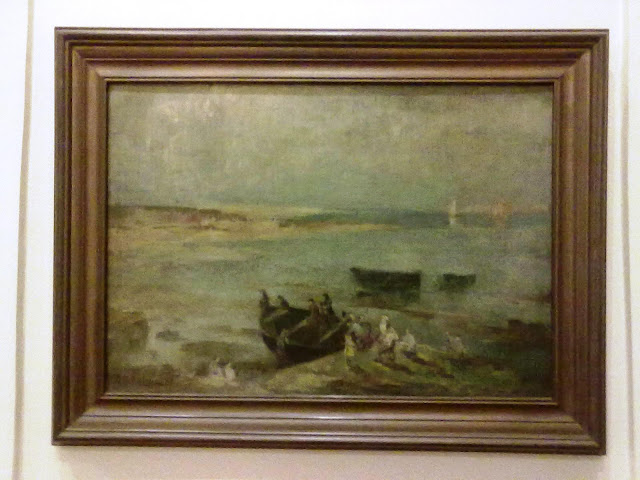 |
| La Playa de un Cadox (1911) |
Title: Portrait of Melecio Figueroa (1903)
Artist: Juan Arellano
Material or Medium: oil on canvas
Subjective Context: Melecio Figueroa, is a noted
Ilonggo artist, engraver, coin designer, a painter, brought up in a
poor family in Arevalo, Iloilo, Philippines.
 |
| Portrait of Melecio Figueroa (1903) |
Title: El golfo (1891)
Artist: Juan Luna
Material or Medium: oil on canvas
Subjective Context: I believe Juan Luna was exposed to the paintings of the Impressionists. Although he never became an Impressionists, his works began to exude a directness and freshness born out of his outgrowing the Salon's values. He began to paint subjects derived from the poorer districts of Paris. His painting "El Golfo" produced during this period is a strong work depicting a crippled boy with crutches. The rough painterly treatment allows for a certain poignancy.
 |
| El golfo (1891) |
Title: Superstition (undated)
Artist: Cesar Legaspi
Material or Medium: oil on canvas
Subjective Context: Well based on it's title, SUPERSTITION, is a belief in supernatural causality:
that one event leads to the cause of another without any physical
process linking the two events, such as astrology, omens, witchcraft,
etc., that contradicts natural science. Cesar Legaspi, painted this to show how the Filipinos are fund of superstitions.
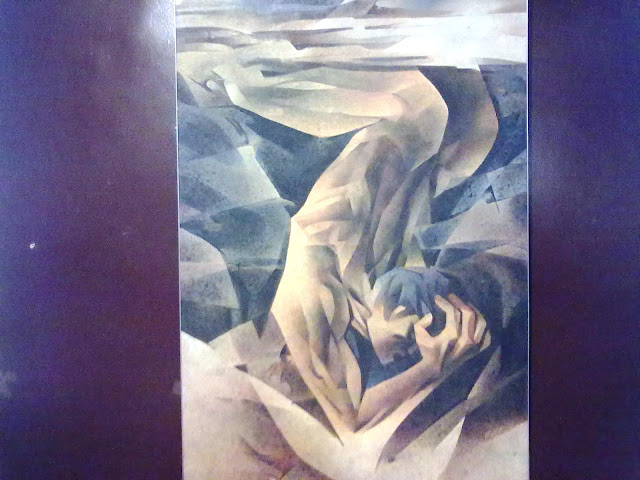 |
| Superstition (undated) | | | | | | | | | | |
5 Sculptures made by the Filipino Artists
Title: Mother and Child (1953)
Artist: Napoleon Abueva
Material or Medium: adobe
Subjective Context: It is about the love of the mother to her child hugging her child wholeheartedly.
 |
| Mother and Child (1953) |
Title: Idiot box (1964)
Artist: J. Elizalde Navarro
Material or Medium: wood
Subjective Context: Idiot box is a slang term for a television which J. Elizalde sculptured to show that in their times, she may be wanted a television.
 |
| Idiot Box (1964) |
Title: Sarimanok (1969)
Artist: Abdulmari Imao
Material or Medium: bronze
Subjective Context: The Sarimanok is a legendary bird of the Maranao people who originate from Mindanao, a major island in the Philippines. It comes from the words "sari" and "manok."
"Sari" means cloth or garment, which is generally of assorted colors.
Manòk, which makes up part of its name, is a Philippine word for chicken.
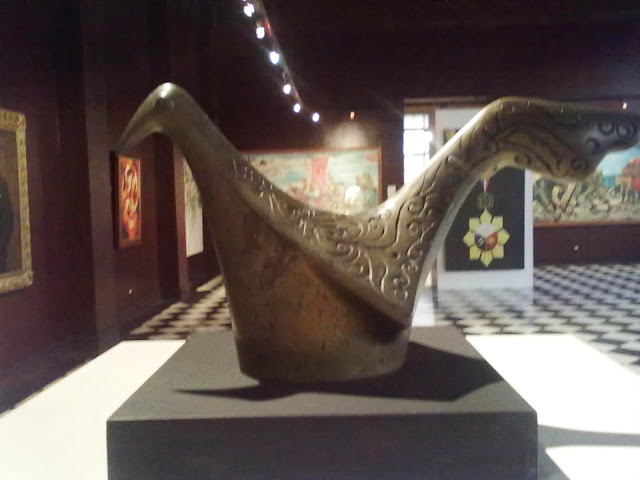 |
| Sarimanok (1969) |
Title: Bust of Gabaldon (1947)
Artist: Gulliermo Tolentino
Material or Medium: marble
Subjective Context: This is the sculpture of Ms. Gabaldon, possibly a respected elder of Gulliermo Tolentino in his times which he sculpted to show his gratitude and honor to the lady.
 |
| Bust of Gabaldon (1947) |
Title: Kaganapan (1970)
Artist: Napoleon Abueva
Material or Medium: bronze cast with gold leaf
Subjective Context: Kaganapan is one of Napoleon Abueva's work of art. Sculpted out of marble in 1952 when Abueva was still a young student at the University of the Philippines, this sculpture won the grand prize in the Arts Association of the Philippines'
annual competition. With a dimension of 91.44 cms. Kaganapan literally
interprets the female reproductive function as a fulfillment to women.
 |
| Kaganapan (1970) |
NATIONAL ARTISTS' WORKS OF ART THAT I LIKE
Title: Planting of the First Cross (1965)
Artist: Vicente Manansala
Material or Medium: oil on canvas
Subjective Context: Having an experience looking in this painting reminds me of what the Filipinos before, treasure their religion. I believe, we Filipinos are very religious.
Title: Superstition (undated)
Artist: Cesar Legaspi
Material or Medium: oil on canvas
Subjective Context: While looking in this painting, I saw curiosity, unsureness and danger. But after I have saw the title of the painting, I said to myself, "Oh, that is why". It is about the urge of the Filipinos to believe superstitions because we Filipinos, are fund of this kind of beliefs especially in ancient times. Well, that is for my own opinion.
Title: Torso (1972)
Artist: Napoleon Abueva
Material or Medium: adobe
Subjective Context: While having a closer look in this sculpture, one thing came out in my mind. "BEAUTIFUL BODY". Well, I guess, ladies here in the Philippines are really beautiful. But I think, it will be better if it has a head with a beautiful face.
Filipino Artistry in their works of art
*This is based on my own point of view"
Title : Planting of the First Cross
Material or Medium : oil on canvas
Location : National Museum (old)
Based on this painting, the Filipinos expressed their artistry in our daily life, burials and religion. First, in our daily life, Filipinos nowadays loved having tattoos in their bodies to let other people know who they are, what they feel, and what do they think. Regarding, to burials and religion. I think, this is literally speaking, as what Ferdinand Magellan have done in the cross. Burying the cross in the ground, is a sign of respect to their religion as Roman Catholics.
Title : First Mass at Limasawa
Material or Medium : oil on canvas
Location : National Museum (old)
In this painting, the Filipinos expressed their artistry in our
daily life, burials and religion. First, in our daily life and religion, Filipinos are known to be very religious, they really treasure their religion and has a strong connection with God. In burials, Filipinos also pray for their loved ones who died so that their souls will be saved. As a matter of fact, Philippines is the only country today that is anti-divorce and anti-abortion, following Israel.
Timeline of the Filipino Art
18th Century
Earliest among the collection are religious in themes and composed of 18th century icons and images created by local artisans under the tutelage of the friars. The devotional pieces of the collection are of outstanding significance.
Coronation of the Virgin
Title : Coronation of the Virgin
Material or Medium : oil on canvas
Location : National Museum (new)
19th Century
During the late Spanish colonial period, the school of Academism or “salon” painting emerged and produced the likes of Juan N. Luna and Felix Resurreccion Hidalgo, who are now considered as 19th century masters.
Spoliarium
Mother’s Revenge
Title : Spoliarium
Material or Medium : oil on canvas
Location : National Museum (old)
Title : Mother's revenge
Material or Medium : terra cotta (clay)
Location : National Museum (old)
1900s
In the succeeding American period, Fernando C. Amorsolo, who was later declared as the First National Artist, rose into fame and established his own style or “school” which was largely characterized by countryside scenery with golden sunlight.
La Descencion de Jesus
Title : La Descencion de Jesus
Material or Medium : wooden plate sculpture
Location : National Museum (old)
1920s
The period is represented by the proliferation of genre themes, landscapes and still lifes as well as the emergence of pre-modernism.
Bust of Mons. G. Aglipay
Title : Bust of Mons. G. AglipayMaterial or Medium : sculpture on marmol
Location : National Museum (old)
1930s: Pre-modernism
Artists represented in the collection: Victorio Edades, Diosdado Lorenzo, Galo Ocampo, Carlos Francisco, Gabriel Custodio, Vicente Manansala, Ricarte Purruganan, Romeo Tabuena, and others.
1942-1945
A suspension on artistic activity was prevalent during the Japanese occupation. However, some visual artists still managed to produce artworks based on the atrocities brought by the war.
Artists represented in the collection: Dominador Castañeda, Demetrio Diego, Diosdado Lorenzo, Romeo Tabuena, Gene Cabrera and others
1946-1949
After the Japanese occupation, the art community sprang back to life. Various themes and styles were explored and pioneered by Filipino artists who gained experience abroad.
Mural painting emerged, spearheaded by Carlos Francisco. Art Association of the Philippines (AAP) was established in 1948.
Burning of Sto. Domingo
Title : Burning of Sto. Domingo
Material or Medium :oil on canvas
Location : National Museum (new)
1950s
The Philippine Art Gallery (PAG) was founded with young modernists as the leading figures. Emergence of different schools of thought (e.g. school of Botong Francisco, school of Manansala, emergence of the “Mabini” art group).
Harana in Manila
Title : Harana in Manila
Material or Medium :image sketched in Steuben glass
Location : National Museum (old)
1960s
Modern art reached its peak.
Ink Fish
First Mass at Limasawa
Planting of the First Cross
Mother and Child
 |
Title : Planting of the First Cross
Material or Medium :oil on canvas
Location : National Museum (old)
|
 |
Title : First Mass at Limasawa
Material or Medium :oil on canvas
Location : National Museum (old)
|
 |
Title : Mother and Child
Material or Medium :adobe
Location : National Museum (old)
|
1970s
Most of the artists in the 1960’s continued to produce important works in this period. Emergence of different movements such as People’s Art or Art for the Masses, Protest Art, Social Realism, and the institutionalization of the National Artist Award (1972). 11 National Artists whose works are represented in the collection:
Fernando C. Amorsolo-1972 (Painting)
Carlos V. Francisco-1973 (Painting)
CINEMALAYA TRIP
The indie-film that I have watched, was entitled "Diablo" it was a comedy film for me because of the fantasized parts of the story, like the chicken that flies even though it has no head. I also ended up laughing because of the comedic acting of the two men which the old lady helped so that they will have a job instead of being a burglars.
The thing that really picked up my curiosity was the shadow that kept the old lady from sleeping. I guess it was her husband who wanted to be by her side until the end.
The story leaves me happy because of the light part of the scenes, at the same time curious of what will happen to the old lady.
But, I didn't like what the two men (former burglars), did in the cross. They made fun of it, as if they were gays that were crucified, which is not the good part of the story.
This story is about your great faith to God.
Possibly, the greatest impact for me in this story is being able to avoid temptations and fighting for your religion.









